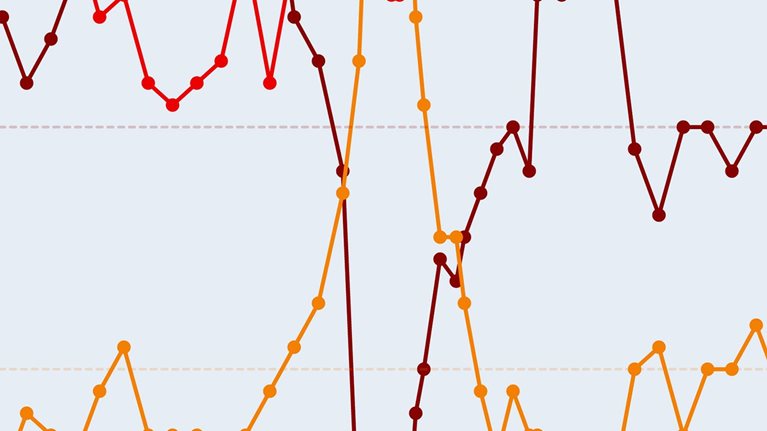Executives in North America report positive economic momentum at home while those in the developing world are less upbeat about their countries’ prospects. These are among the key findings from our most recent survey on economic conditions,1 in which respondents from North America are most likely to report improved country-level conditions, to expect that conditions will be better still in six months, and to believe that jobless rates will fall.
At the same time, respondents in North America have a warier view of the global economy than their peers elsewhere, resulting in a fragmented outlook and tempered optimism about the world economy as a whole. On average, executives are still more positive than negative about current and future global conditions. But growing shares of respondents say that over the next year, geopolitical instability will pose a threat to global growth—and that a sharp slowdown in China’s growth is likely to occur.
Global uncertainty
After three surveys in which executives were increasingly bullish about current and future conditions in the world economy, this optimism has stabilized. Thirty-seven percent of respondents say current conditions are better now than they were six months ago, down from 45 percent in March,2 while a slightly larger share says conditions have stayed the same (Exhibit 1). Looking ahead, 41 percent expect conditions will improve in six months’ time (Exhibit 2). In North America, respondents are more positive than all others about their own countries’ prospects yet have the least optimistic outlook for the global economy.
Steadying global conditions

A wary outlook from North America

The skeptical view from North America may arise in part from concern over new global threats—namely, geopolitical instability. Among executives in the region, 62 percent cite this as a risk to growth in the world economy, up from just 38 percent in the previous survey. Geopolitical instability is a global worry, too: the largest share of all respondents now cites it as a potential risk to worldwide economic growth (Exhibit 3). Increased economic volatility and sovereign-debt defaults follow as high-ranking threats. Meanwhile, low consumer demand has become a less pressing issue since March, as have concerns related to government, such as a lack of policy support and domestic political conflicts.
Worries over instability and volatility

Debt concerns aside, one-third of respondents expect the eurozone’s economy to grow over the next six months, and an even larger share of executives in the region now say the same (Exhibit 4). Meanwhile, increased shares of respondents suggest that Asia will be a source of global economic uncertainty over the next year. Compared with three months ago, executives are now more likely to expect a sharp slowdown in China’s growth—not surprising, given the reports of contracting manufacturing activity and slowing export growth released around the time of the survey’s launch.3 A larger share than in March also expects to see geopolitical instability in Asia over the next 12 months.
Potential for eurozone growth

At home, views diverge
While there is evidence that the global economy’s recovery is under way,4 the responses indicate that slackening growth and pessimism in some parts of the world are offsetting the progress (and relative optimism) in others. On average, the same shares of executives say conditions in their home economies have improved—and will improve in six months—as did in March. But as in previous surveys, opinions continue to differ greatly by geography (Exhibits 5 and 6). Across regions, executives in North America are the most positive about current and future conditions at home; they are also much more upbeat than they were three months ago.
Improving conditions in North America . . .

. . . amid cautious emerging-market views

The opposite is true in developing markets,5 where 43 percent say current conditions are worse than six months ago (up from 31 percent in March). Additionally, just 35 percent say things will be better in six months’ time, down from 47 percent three months ago. After months of reporting positive expectations, these executives are now just as likely to expect conditions at home will stay the same as they are to expect improvements. In the eurozone, the largest share of respondents says conditions will stay the same.
Across geographies, the risks most often identified as threats to domestic growth are the same ones selected in March: low consumer demand, a lack of government-policy support, and political conflicts. A slightly larger share of respondents now also cites increased economic volatility, which is of particular concern among executives in developed Asia.6 The top-ranked risk to country-level growth over the next ten years is low levels of innovation.
More upbeat news in North America
Beyond their growing confidence about conditions at home, respondents in North America note some other positive indicators of their countries’ economic prospects. These executives are twice as likely as the total average (40 percent, compared with 20 percent) to expect their countries’ unemployment rates will decrease over the next six months, even though the jobless rate in the United States edged up slightly in May.7 At the company level, larger shares of respondents in the region now expect that customer demand for their products and services will increase and that their workforces will grow.
What’s more, respondents are becoming more optimistic about the longer-term effect of recent government-spending cuts and tax increases on the United States’ economy. In this survey, 31 percent of all respondents expect a positive impact on growth over the next three years, up from 21 percent in March and 17 percent in December. Respondents in North America are still more negative than all others, with just 21 percent predicting a positive effect from these measures. Nonetheless, their expectations are slightly more upbeat now than three months ago, when just 17 percent said the same.

